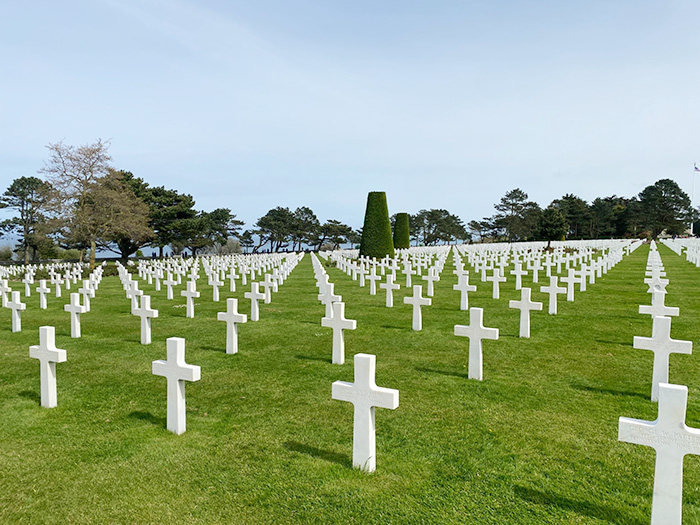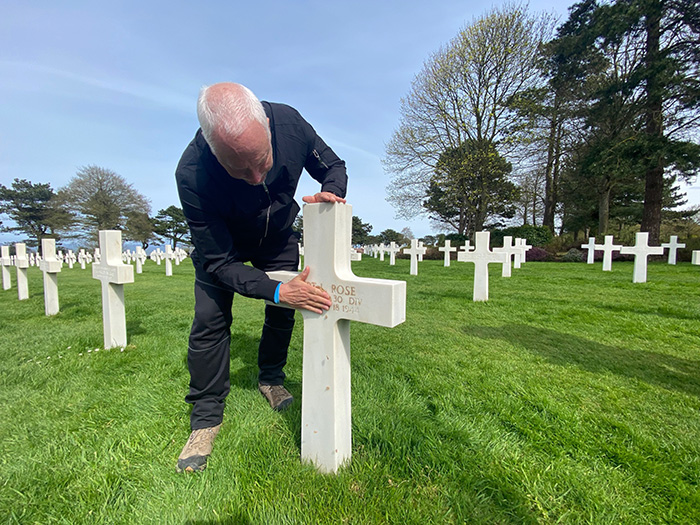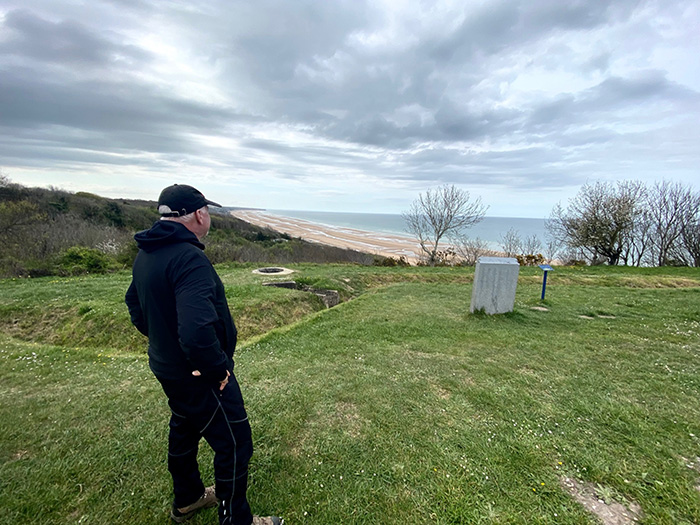By Matt Rozell, Special to The Chronicle
The final leg of our European trip to make a documentary about my book A Train to Magdeburg — the events depicted in a famous scene of Jewish survivors rescued by American soldiers, and all that transpired since I discovered the photo — took us from Germany to Normandy, France, to Omaha Beach and to the American Cemetery and Memorial located in Colleville-sur-Mer.
We were there to document the beaches I had been studying, teaching and writing about for the past 40 years — the place where the liberators I wrote about in Train to Magdeburg came ashore, some on D-Day and some later.

Ten months after holding off desperate German counterattacks meant to push them back into the sea, our then-battle-hardened soldiers, rescuing a train of would-be Holocaust victims, would be shocked by the reality of industrial scale genocide; indeed, they would realize what they were fighting for.
Most impactful was our visit to the American Cemetery at Colleville-sur-Mer.
Marble headstones at Normandy
Just two days after the beginning of the D-Day invasion, the first American dead were laid to rest in a makeshift cemetery just off the beach.
A few years later, the bluffs overlooking Omaha Beach would become the American Cemetery at Colleville-sur-Mer.
Today, nearly 9,400 Americans lay at rest on more than 170 acres of sanctified ground meticulously maintained by the American Battle Monuments Commission, watched over by the 22-foot-tall bronze statue, ‘Spirit of American Youth Rising from the Waves.’
We had called ahead to secure permission to film. I was stunned at the serene beauty and peacefulness of the site, and the dedication of the staff who gave us the white glove treatment, allowing us to enter roped-off sections, past row after row of marble headstones.
I tried to touch the top of each one.
Small crowds of tourists gathered and craned in curiosity as as I was shown photographs and told personal stories of the young soldiers by ABMC staff: A student here. A schoolteacher there. Lawyer. Farmboy. Mechanic. Shopkeeper. Playboy. Young father. Brother. Son.

I also paused at General McNair’s grave. At 62 he was the oldest person buried here, as well as at the resting place of General Theodore Roosevelt, Jr. — the highest-ranking officer to come ashore at Utah Beach on D-Day, who was felled by a heart attack six days later.
It’s a moving place.
Remembering their efforts
About a third of the World War II families with loved ones killed overseas opted not to repatriate their remains after the war, knowing they will be cared for and rest perpetually with their fallen comrades in arms.
Our day ended with us being allowed to film the flag lowering ceremony at 5 p.m.
Back at the hotel, a teenage American student sat with us in the sitting room, listening in as we debriefed ourselves on our trip.
We talked about what following in the footsteps of the American soldier-liberators and the Holocaust survivors they rescued meant to us. For me, it added an almost spiritual dimension to this story of World War II that reveals mankind at its absolute worst, but also at its shining best.
We can’t risk forgetting how the murder of six million began with words, with neighbors and friends turning away.
We hope our film will offer up what happens when “ordinary” people put themselves in harm’s way to exemplify the greatness that human beings are capable of.
Humbled at Omaha beach
We had told our expert guides, two British expats living in France, we wanted to see the exact locations of the landing of elements of the 743 Tank Battalion on June 6, 1944, 10 minutes before H-Hour on D-Day.
Of the five Allied beachheads established that day along 35 miles of the Normandy coastline, Omaha Beach was the bloodiest. Our guide Nigel wanted us to get there early, when the tides would be similar to what Allied planners were hoping to encounter.
It was a cool overcast morning, not unlike in 1944, when Nigel led us down to this westernmost section of Omaha Beach where the soldiers had struggled ashore.

The tide was rushing in fast, rising 12 feet in a matter of minutes. It would have hidden beach obstacles and pole mounted mines quickly. Many soldiers, weighted down, drowned.
After filming a while, we lost sight of our cameramen Josh for an hour.
The water was rushing in so fast that I was actively scanning the surf, worried that he, in walking backward while looking down into the camera lens, may have lost his footing. He turned up just as we considered sounding the alarm, having walked midway down the five-mile-long Omaha Beach.
Nigel told us more stories of the men, the heroism, the tragedy of that day. Just before where we were standing, 100 men out of a company of 150 were killed.
It was humbling to be here.
A small airfield
Later, deeper into the countryside, we found the small airfield where filmmaker Mike Edward’s grandfather served in the summer of 1944, supporting fighter planes that followed the troops.
These hundreds of makeshift grass airstrips throughout northern France had typically reverted to agricultural use immediately after the battles.
It was an emotional moment for Mike, to be in the spot where his grampa had served.
‘Liberated the heck out of it’
I asked to see where Operation Cobra was launched, a planned breakout, where men of our tank battalion in support of the 30th Infantry Division and others would race in to encircle German forces. As planned, heavy bombers of the Eighth Air Force flying out of England would pound the enemy.
Unfortunately, many dropped their bomb loads early, on US troops, resulting in hundreds of casualties from friendly fire, including General McNair, the top American general killed in the European Theater, who was observing the action with the 30th Infantry Division.
Today, the approximate site of his demise is recently plowed farm fields. With my archaeological training it was easy to spot metal fragments littering the area.
Stopping quickly to visit the 800-year-old reconstructed cathedral in the City of Saint-Lô, we saw a shell still protruding from the wall and recalled the lore: How one dumfounded GI said, as troops entered the destroyed town: “We sure liberated the hell out of this place!”
At Hill 314, emotional visit
At Mortain, we visited the site of a climactic week-long battle where the men of the 30th held the high ground against overwhelming forces, and saved the Allied breakout — but fewer than half the 700 survived.
We did more interviews and filmed up on this ancient hilltop, with glimpses of the famous cathedral Mont Saint-Michel shimmering in the distance.
The hill known for a thousand years as Mont Joie is now remembered by the US Army appellation ‘Hill 314’ in Normandy.
Between takes, in the spring sun I closed my eyes. The breeze rose and murmured through the pines, where I later learned bodies had been laid — after being searched desperately for food or weapons — while their vastly outnumbered brothers staved off a siege of evil in August 1944.
An elderly couple walking a dog spoke to me when they noticed the cameras.
I told them what we were doing, and the man’s eyes welled as he gripped my arm and thanked me for caring. It seems he takes care of the local memorials to the American fallen.
What they did mattered
In 2020, the 30th Infantry Division finally received the Presidential Unit Citation in honor of its heroism here.
What they did mattered, and their actions are lessons that will make us better if we remember, and teach the world what they did.
Film director Mike Edwards on $2 million ‘Magdeburg’
Chronicle Managing Editor Cathy DeDe writes: Mike Edwards, a 12-time Emmy winning director in Columbus, Ohio, said he got involved with Matt Rozell’s Train to Magdeburg documentary project while he was looking for a followup to his Emmy winning 2015 film called Searching For Augusta.
Simply, he says, “I heard about this story and contacted Matt Rozell.”
Of the Germany trip covered in Mr. Rozell’s Chronicle series, Mr. Edwards says, “My takeaway was the pure inspiration of the German high school students and historians there, who have studied this story and have a deep desire to keep the messages this story conveys alive to share with generations to come.”
Still on tap: A fund-raising campaign to raise $2 million to complete the film. To date, $110,000 has been raised, he said.
“It’s ambitious,” Mr. Edwards says. “But I know we can do it and we won’t stop until we reach our goal.”
He said “This will cover the production of the film, the creation of educational materials, fund screening and educational outreach efforts.”
Meanwhile, “There is much more filming to be done,” including an interview in Toronto with another survivor.
He said, “If I had my guess, we would have a film completed by the fourth quarter of 2023. We are dependent on raising the needed funds to complete the project.”
He said, “We have hired a professional firm here in Columbus to assist with that. Find details on the website of the Augusta Chiwy Foundation, which is producing the film: AugustaChiwy.org.
Mr. Edwards also offered a link to a promotional piece on the film, which also includes a brief soldier-survivor reunion, at https://youtu.be/7L1hHK5UkPo.
‘Storyteller’
Mr. Edwards added, “People have asked me why I have spent five years of my life trying to get this project made.
“My answer is simple. I am a dad and a storyteller. I need to use what I have to tell stories to show my kids, and anyone who will listen, what is right and inspire them with the films I can make to care for humanity, to show what is means to be human.”
Copyright © 2022 Lone Oak Publishing Co., Inc. All Rights Reserved
 Glens Falls Chronicle Serving the Glens Falls/Lake George region; Warren, Washington and northern Saratoga counties since 1980
Glens Falls Chronicle Serving the Glens Falls/Lake George region; Warren, Washington and northern Saratoga counties since 1980

